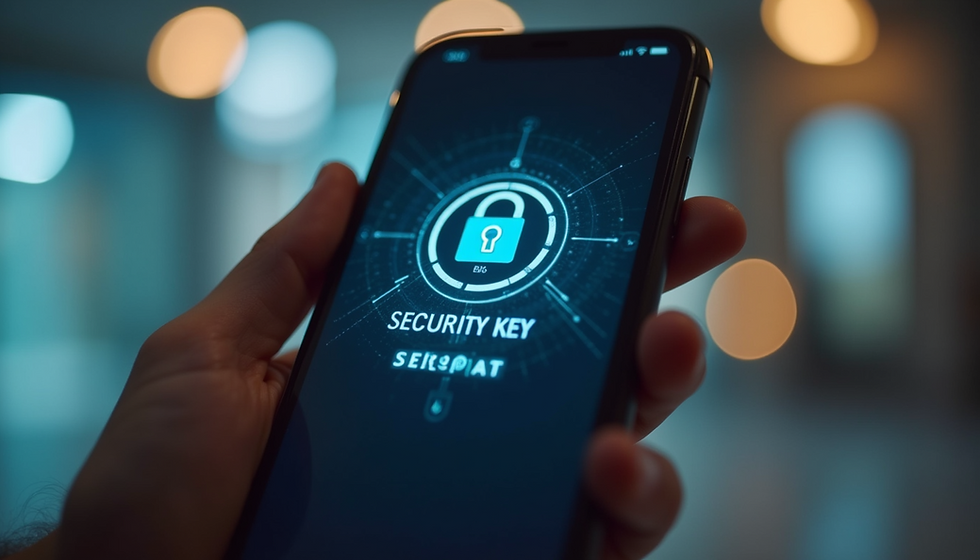Unpacking Passkey Authentication for Beginners
- tech012
- Oct 6
- 4 min read
Security is a top priority for any website or app. Passwords have been the go-to method for years, but they come with many problems. Weak passwords, reuse, and phishing attacks make them risky. That’s why new methods like passkey security options are gaining attention. They promise a safer, smoother way to log in without the hassle of remembering passwords.
If you want to improve your site’s security and user experience, understanding these options is essential. Let’s dive into what passkey security options are, how they work, and why they matter.
Exploring Different Passkey Security Options
When we talk about passkey security options, we mean ways to authenticate users without traditional passwords. These methods use cryptographic keys stored on devices or in secure environments. Here are some popular options:
Biometric Authentication: Uses fingerprints, facial recognition, or iris scans. It’s fast and user-friendly.
Hardware Security Keys: Physical devices like USB or NFC keys that users plug in or tap to verify identity.
Device-Based Passkeys: Stored securely on smartphones or computers, these keys replace passwords for logging in.
Each option has its strengths. Biometrics are convenient but require compatible hardware. Hardware keys offer strong security but need users to carry a device. Device-based passkeys strike a balance by leveraging built-in security features on modern gadgets.
Choosing the right option depends on your audience and platform. For example, a mobile app might benefit most from biometric or device-based passkeys. A corporate environment might prefer hardware keys for added control.

What is passkey authentication?
Passkey authentication is a modern login method that replaces passwords with cryptographic keys. Instead of typing a password, users authenticate using a private key stored securely on their device. The public key is registered with the service, allowing it to verify the user without ever seeing the private key.
This approach eliminates many risks associated with passwords. There’s no password to steal, guess, or reuse. It also protects against phishing because the authentication process is tied to the specific website or app.
Here’s how it works in simple terms:
Registration: The user creates a passkey on their device. The device generates a key pair - one public, one private.
Storage: The private key stays on the device, protected by hardware or software security.
Authentication: When logging in, the device proves possession of the private key by signing a challenge from the server.
Verification: The server checks the signature using the public key and grants access if it matches.
This process is seamless and fast. Users don’t need to remember anything or type passwords. It’s also highly secure because the private key never leaves the device.

Why Passkey Security Options Matter for Your Website
Switching to passkey security options can transform your website’s login experience. Here’s why it’s worth considering:
Stronger Security: Passkeys prevent common attacks like phishing, credential stuffing, and brute force.
Better User Experience: Users avoid the frustration of forgotten passwords and complex rules.
Reduced Support Costs: Fewer password resets mean less time and money spent on customer support.
Future-Proofing: As browsers and platforms adopt passkey standards, early adopters gain a competitive edge.
For businesses, these benefits translate into higher conversion rates and happier users. Imagine a checkout process where users log in instantly without typing passwords. That ease can reduce cart abandonment and boost sales.
Developers also appreciate the simplicity. Many platforms now offer APIs and SDKs to implement passkey security options quickly. This means you can add strong authentication without reinventing the wheel.
How to Implement Passkey Security Options Effectively
Getting started with passkey security options might seem daunting, but it doesn’t have to be. Here are practical steps to help you implement them smoothly:
Assess Your Current Authentication: Identify pain points and security gaps in your existing system.
Choose the Right Passkey Option: Consider your users’ devices and preferences.
Use Trusted Providers: Partner with services that offer easy integration and robust security.
Educate Your Users: Provide clear instructions and reassurance about the new login method.
Test Thoroughly: Ensure compatibility across browsers and devices.
Monitor and Improve: Collect feedback and analytics to refine the experience.
For example, OnzAuth offers a streamlined solution to add passwordless login with passkeys. Their platform supports multiple passkey security options and simplifies backend integration. This can save you time and reduce development headaches.
Remember, the goal is to make authentication both secure and effortless. Start small if needed, perhaps by offering passkey login as an option alongside passwords. Gradually, you can encourage users to switch fully.

Looking Ahead: The Future of Secure Authentication
The shift towards passkey security options is just beginning. As technology evolves, we’ll see even more seamless and secure ways to authenticate users. Passwords will become a thing of the past.
Web standards like WebAuthn and FIDO2 are driving this change. They enable interoperability across devices and platforms, making passkey authentication accessible to everyone.
For businesses, embracing these changes early means staying ahead of security threats and user expectations. It’s an investment in trust and convenience.
If you want to learn more about how to implement passkey authentication and explore solutions that fit your needs, check out resources from trusted providers. The future of login is here, and it’s simpler and safer than ever.
By understanding and adopting passkey security options, you’re taking a big step towards a more secure and user-friendly digital experience. It’s a smart move that benefits both your business and your users. Keep exploring, stay curious, and enjoy the journey to passwordless authentication!



Comments